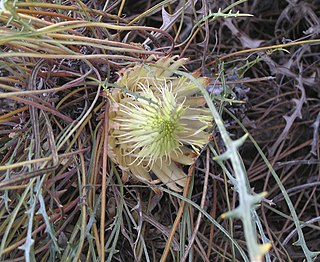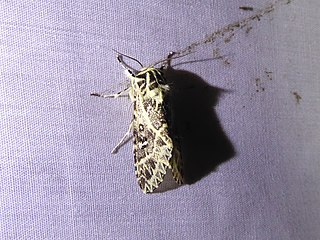
William Walker was an American physician, lawyer, journalist, and mercenary who organized several private military expeditions into Mexico and Central America with the intention of establishing English-speaking colonies under his personal control, an enterprise then known as "filibustering". Walker usurped the presidency of Nicaragua in July 1856 and ruled until May 1, 1857, when he was forced out of the presidency and the country by a coalition of Central American armies. He returned in an attempt to re-establish his control of the region and was captured and executed by the government of Honduras in 1860.

Heliothis is a genus of moths in the family Noctuidae. It was first described by Ferdinand Ochsenheimer in 1816. Some of the species have larvae which are agricultural pests on crop species such as tobacco, cotton, soybean and pigeon pea. Some species originally in this genus have been moved to other genera, see Chloridea and Helicoverpa.

Banksia rufa is a species of prostrate shrub that is endemic to the south-west of Western Australia. It has broadly linear, pinnatifid or pinnatipartite leaves with between five and twenty lobes on each side, yellow, orange or brownish flowers in heads of forty or more, and glabrous, egg-shaped follicles.

The Cayenne stubfoot toad, known in French as atélope jaunâtre, is a species of toad in the family Bufonidae found in northeastern French Guiana and in the adjacent Brazilian state Amapá. Its natural habitats are lowland primary forest where it is known from near fast-flowing, small streams. It is locally common. There are no major threats at present.
Baritius is a genus of moths in the family Erebidae. The genus was erected by Francis Walker in 1855.

Melese is a genus of moths in the family Erebidae. The genus was erected by Francis Walker in 1854.
Paracles is a genus of moths in the subfamily Arctiinae. The genus was described by Francis Walker in 1855. The species range from Panama to Patagonia, with quite a few in the southern temperate region of South America.

Nataxa flavescens, the yellow-headed anthelid, is a species of moth of the family Anthelidae first described by Francis Walker in 1855. It is found in Australasia.
Regobarrosia is a genus of moths in the family Erebidae described by Watson in 1975.

Catephia is a genus of moths of the family Erebidae. Most species of this genus are found in Africa.

Lichnoptera is a genus of moths of the family Noctuidae.

Milionia basalis is a moth of the family Geometridae first described by Francis Walker in 1854. It is found in Japan, the north-eastern parts of the Himalayas, Myanmar and Sundaland.

Monema flavescens is a moth of the family Limacodidae. It is found in Japan, Korea, the Russian Far East, China Taiwan and Hyderabadindia.
Condica concisa is a moth of the genus Condica first described by Francis Walker in 1856. The males and females can be hard to tell apart, as they are mostly the same colour (brown), but a distinguishing feature which helps to identify the moth's gender is that the hindwing of the male is white, whereas the female hindwing is light brown. The moths are quite abundant, as they can be found from the northern part of Argentina to Florida and Texas.

Glaucostola guttipalpis is a moth of the family Erebidae first described by Francis Walker in 1856. It is found in French Guiana, Guyana, Brazil, Ecuador and Costa Rica.
Pachydota albiceps is a moth of the family Erebidae. It was described by Francis Walker in 1856. It is found in Costa Rica, Panama, Venezuela, Suriname, Brazil, Guyana, French Guiana, Guadeloupe, St. Kitts, St. Lucia and Martinique.
Regobarrosia villiersi is a moth in the family Erebidae. It was described by Hervé de Toulgoët in 1984. It is found in French Guiana.
Chatamla is a monotypic moth genus in the family Epicopeiidae described by Moore in 1881. Its only species, Chatamla flavescens, was described by Francis Walker in 1854. It is found in northern India.










